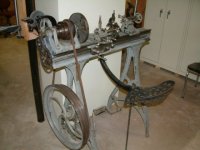In my experience, the most commonly found color is black. However, I have seen them in gray (ligher & darker) as well as brown and some very early ones in green. Think the lighter gray is simply dark gray that has faded.
Paint has a tendency to fade when exposed to sunlight so looking for places that were not exposed such as where two parts are bolted together our up under and between things might lead to a better approximation of the proper color.
I have seen a fairly large number of Barnes metal lathes from the cute little #4 to the massive #6 (both velociped, true treadle and bench/line shaft models) and have seen no indication that any of there metal lathes ever had any pin striping so getting that done should not come into play.
As Joe pointed out, most are missing parts and pieces. Your "opportunities" both sound manageable. Change gears, steady rests, wood turning attachments, etc., as well as the foot powered parts are ususlaly missing. Might be able to help with change gears and steady rest and hope to have the wood turning attachment reproduced at some time.
The #3 wood lathe as Joe mentioned is very highly decorated and is a real beauty. She works great and is a pleasure to operate. Just got a good video camera and hope to get some good videos of a lot of the Barnes machinery running something later this spring.
The Barnes line of metal lathes seems to be a little lighter in build especially when compared to Seneca Falls and Reed. Yes, you will find them in a lot of places and for some reason, they tend to show up in chicken coops, barns and outbuilding more than inside a shop. Never know.
With their wood working machines, Barnes assembled them and then painted. I have been able to find some great paint runs and have what I think are good color matches for the Barnes gray and "burnt red" colors. (Never heard of a burnt red metal lathe.) Have had great success with using Benjeman Moore IronClad paint. The water based seems to work just as well as the oil base and drives very quickly. If you want that paint color mix, let me know.
For some additional information on foot powered machinery, see my website at
Foot Powered Machinery Yes, a work in process with mostly info today of the Barnes scroll saw and former. Hope to get more out there especially on the Barnes lathes. Have a couple of #3's under restoration and that should help.
Have a Barnes #6, early gear drive metal lathe coming. It has a 7 foot bed and 6, yes six, pedals between the legs. A watch makers lathe, I think he called it.
Good luck with your restoration.
Thanks Ed



